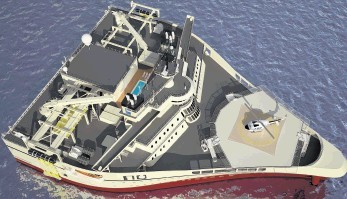
PGS has order a further pair of gigantic Ramform-style seismic survey vessels from Mitsubishi of Japan.
This brings the order book for Titan class Ramforms to four. When completed, they will take the Petroleum Geo Services fleet of these remarkable-looking ships to 11.
The estimated total cost for each of the two vessels to be delivered in 2013 is approximately $250million, including commissioning and a comprehensive seismic equipment package, but excluding capitalised interest. It is assumed that the two further units will be around the same price.
The first of the Titans is due for delivery during the first quarter of next year. The second should appear late next year, the third in the first half of 2015 and the fourth later that year.
Roughly shaped like a domestic iron, it’s as if someone took a huge oil tanker, chopped off the bows and kept them, and threw the main body of the vessel away.
Basically, Ramforms are all bow and stern, of cellular build and have proved excellent for towing large numbers of seismic streamers reliably. The Titans will be the largest yet and will be capable of towing the largest seismic cable arrays ever devised.
The new generation Ramforms will strengthen PGS’ clearly unique position in the seismic industry and the decision to renew and expand the fleet comes at a time when demand for marine seismic services is increasing.
The vessels are designed to utilise and extract the full potential from the company’s flagship GeoStreamer technology.
The Titan class is based on the demonstrated strengths of the current Ramform fleet, while improving capabilities.
They have been designed to operate in the high density segment of the 3D seismic market, where large spreads, long streamers and towing efficiency are the key success factors.
The Titans will be able to tow up to 24 streamers versus eight to a dozen for first generation Ramforms built in the mid 1990s. For now, PGS claims that the best its competitors can manage at this time is up to 14 streamers.
The high-density segment is driven by deep water exploration and production in geologically complex areas such as Brazil, West Africa and the Gulf of Mexico.
The GeoStreamer technology is also opening up new markets in mature basins, such as the North Sea, where the higher fidelity data can reveal new geological plays.
The Ramform Titan class measures 104.2m length overall by 70m breadth across the stern, which is the widest part of the vessel. Draft is 6.4m.
They will carry enough fuel to stay at sea for up to 150 days and will be capable of a transit speed of 16 knots. A power-station style diesel-electric propulsion system is fitted . . . six large diesels delivering up to 18 megawatts combined through triple controllable pitch nozzle propellers.